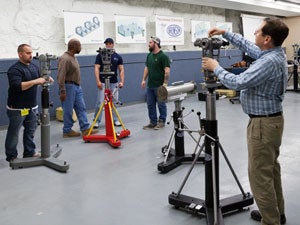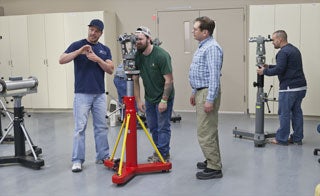Optical Tooling Theory & Applications
Benefits Of Optical Tooling
 Employ optical alignment procedures to enhance productivity and performance, and to decrease down time during maintenance and equipment installations. Control vibrations of critical rotational components to help maximize machine life. Increase production speeds without compromising product quality. Inspect fixtures and final assemblies for dimensional accuracy. Incorporate optical measurement with a preventative/predictive maintenance program to monitor manufacturing processes.
Employ optical alignment procedures to enhance productivity and performance, and to decrease down time during maintenance and equipment installations. Control vibrations of critical rotational components to help maximize machine life. Increase production speeds without compromising product quality. Inspect fixtures and final assemblies for dimensional accuracy. Incorporate optical measurement with a preventative/predictive maintenance program to monitor manufacturing processes.
Learning Objectives
Become familiar with principles of light and optics, and how they work in various optical devices. Know how to operate each optical tooling instrument and what measurements each will perform. Define and work with optical tooling accuracy in both angular and linear terms. Determine the proper targeting for any application. Fully understand precision measurement techniques and apply these techniques to actual measurement projects. Troubleshoot a prospective alignment project to determine an effective, timely solution. Perform classical optical tooling alignment projects. Know how to field calibrate an instrument and adjust it to achieve the manufacturer’s specification.
Course Outline
| Principles Of Optics And Light Refraction, auto-reflection, auto-collimation, collimation, colineation, parallax. (Introduced in reading prior to class.) |
Optical Tooling Accuracy Definition, angular-to-linear conversion, instrument accuracies, project accuracies |
| Function Of Optical Devices Lens, prism, wedge |
Targeting Paired lines (proper spacing, optical tooling scales), circles/spheres, tooling balls, reference points (setting benchmarks), "shooting" guidelines |
| Basic Instrument Construction Ocular system, objective system, focusing method |
Precision Measurement Techniques Set-up considerations, precision leveling, "bucking in", turning right angles, normalization |
| Optical Tooling Instrumentation Linescopes, precision sight levels, jig transits, complete accessories (stands, targets, fixtures, mirrors). |
Projects/Applications Simulation/discussion of students' specific projects |
Who Should Attend The 32-Hour Theory & Applications Course?
 The 32-Hour Optical Tooling Theory And Applications Course is designed for people who: Perform precision optical measurement tasks. Define alignment procedures. Specify optical measurement equipment requirements. Require an understanding of optical measurement technology.
The 32-Hour Optical Tooling Theory And Applications Course is designed for people who: Perform precision optical measurement tasks. Define alignment procedures. Specify optical measurement equipment requirements. Require an understanding of optical measurement technology.
Course content is appropriate for project engineers, manufacturing engineers, production supervisors, tooling and fixture designers, quality assurance/inspection personnel, maintenance staff, field service representatives, technicians, and others who encounter critical alignment parameters in their work.
Theory & Applications Course Format
All Brunson Instrument Company training employs a hands-on approach. The 32-hour Optical Tooling Theory and Applications Course allows students to spend approximately 80% of their time developing skills with optical instruments and accessories, and performing measurement functions applicable to real-life situations. The remaining 20% is spent in a classroom setting. Students typically work individually or in teams of two. The course is limited to four (4) students to maximize personal instruction.


